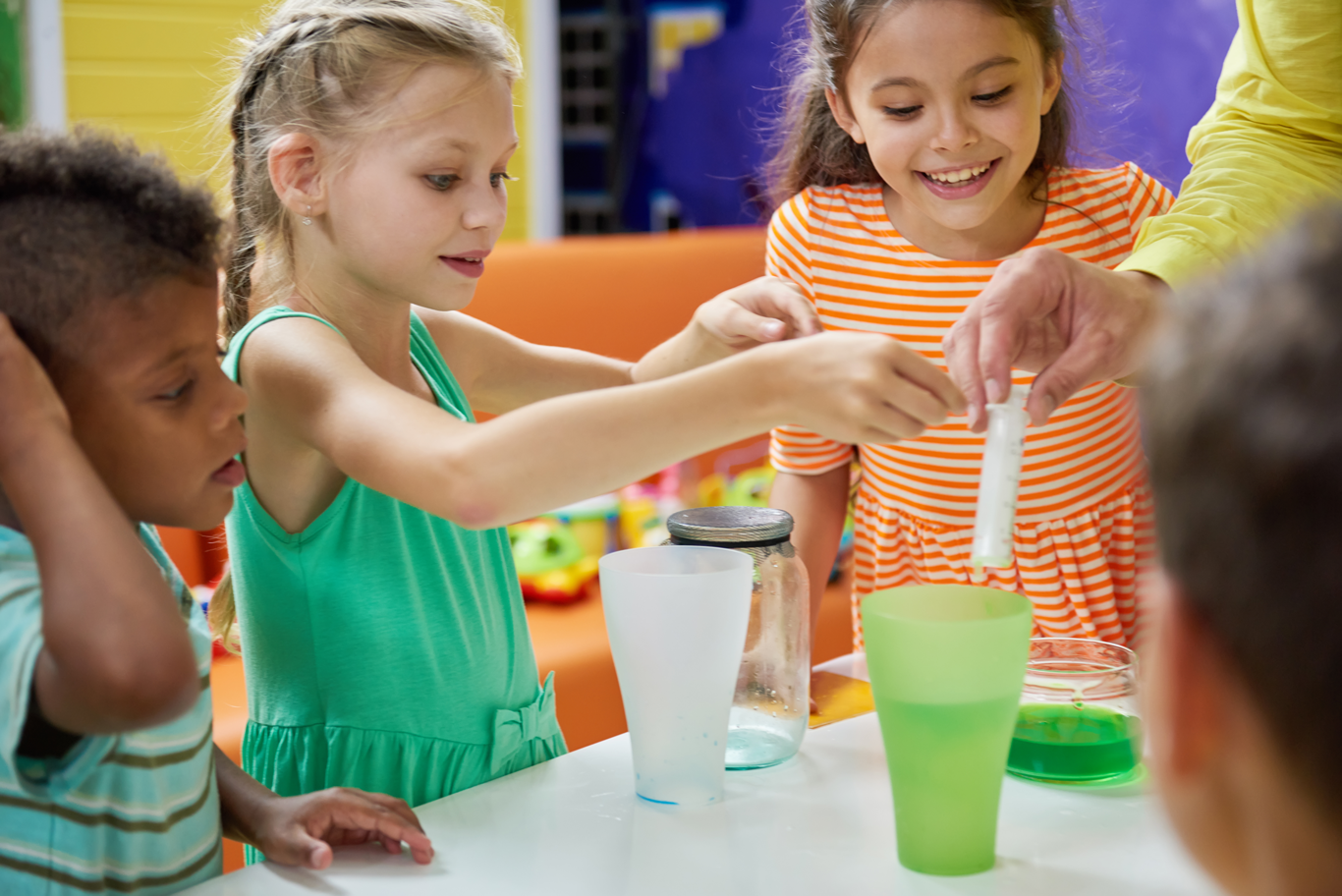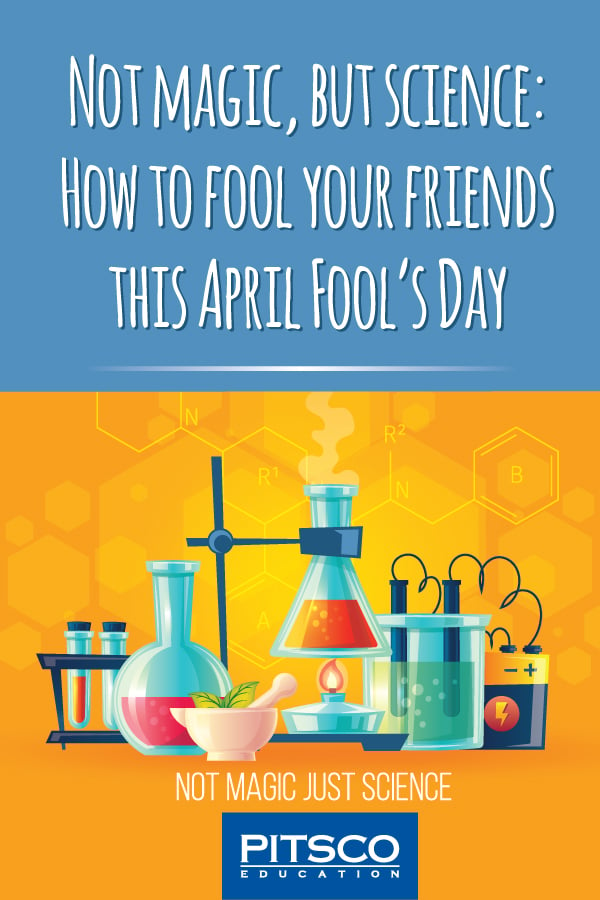Updated 6/11/24
Editor’s Note: The following experiments are not original ideas. The specific projects we’ve shared are adapted from Scout Life, Life Over C’s, Steve Spangler Science, ThoughtCo., and Wonderopolis. We encourage you to give their sites some exploration for more STEMspiration and ideas for learning at home.
April Fool’s Day — it’s a holiday you either love or love to ignore.
So, we’ll tell you straightaway, we don’t have any big pranks up our sleeves. But, we’re all for curiosities and some good-natured learning, so we set out to find a few science/STEM tricks you can try at home (or in a classroom).
You’ll need a small candle, a glass, a plate, a lighter or match, and water.
- Place a small candle upright in the middle of a plate.
- Light the candle.
- Pour some water onto the plate.
- Place the glass over the candle.
- As the flame extinguishes, the water on the plate is sucked into the glass.
How does that work?
Per Scout Life, “When the candle is burning inside the glass, the heat makes the air expand, so some of the air escapes outside the glass. The candle goes out after it uses up all the oxygen, so the air inside the glass cools. As it cools, the pressure inside the glass drops. Some of the carbon dioxide formed by the flame dissolves in the water as well, decreasing the pressure even more. The water outside the glass on the saucer is forced into the glass by the higher air pressure outside.”
You’ll need a standard pencil, a glass, vegetable oil, and water.
- Fill the glass with half water and half vegetable oil.
- Try to break the pencil.
- Insert the pencil into the water and rotate until the pencil appears broken from the side.
- Fix your pencil by pulling it out of the water.
How does that work?
In short, light refraction. Per the blog, Life Over C’s, “A light wave travels through a medium using a process known as refraction. Light waves can travel through objects like air, water, oil, and glass, but not through a pencil itself. Light is refracted differently through oil than water, which is why the results are more dramatic with a glass filled with half oil and half water. The light waves travel fastest through air, a little slower through water, and the slowest through oil. That is why the pencil looks so dramatically broken when you move it through the glass and look at it from different angles. You can magically ‘fix’ the broken pencil by changing where the pencil is positioned in the glass.”
There is a balloon version of this activity, but for the bag option you’ll need to gather five sharpened pencils, a quart-size resealable plastic bag, water, and a bucket (optional).
- Sharpen four or five pencils to a sharp point.
- Fill a resealable plastic bag two thirds full with water and seal.
- Hold a pencil in one hand and the top of the bag in the other hand. Slowly pierce the pencil through one side of the bag and halfway out the other side. If you’re feeling hesitant, do this over a bucket or the sink. (If you have a sibling, friend, or parent nearby, one person can hold the bag and one person can pierce the bag with the pencil.)
- Repeat with other pencils.
Did it leak? NOPE. Or at least it shouldn’t have.😁
How does that work?
According to ACS Chemistry for Life, “The molecules that make up the plastic bag and the balloon are very flexible. When the pencil or skewer go through the material, the molecules shift and mold themselves around the poking object. This flexibility creates a seal so that the water or air does not leak out.”
Here’s what you’ll need: two small identical glasses, water, vegetable oil, and a thin waterproof card, such as an old hotel key, gift card, or driver’s license. (As a variation, Scout Life offers a version with salted water instead of oil that shows how to keep water separate.)
- Fill one glass completely full with water. (You can add a few drops of food coloring if you want a more dramatic experience.)
- Fill the other glass completely full with vegetable oil.
- Cover the water glass with the plastic card. Hold the card in place and flip the water glass over, setting the card on top of the second (oil) glass.
- Line the glasses up. The rims should be even. Slide the card slightly, just enough to create a little bit of open space at the edge of the glasses.
- Within the next several minutes, the liquids will trade places. The oil will rise to the top while the water will sink and fill the bottom glass.
How does that work?
Thought Co. comes in with the science behind this card trick. “The two liquids have different densities from each other. Basically, the lighter liquid will float while the heavier liquid will sink. You would see the same result if you had removed the card entirely, except this way is prettier and looks more magical.”
Your materials list, courtesy of Scout Life:
- 1 tablespoon baking soda
- 1/4 cup water
- Grape juice*
- Small paintbrush or cotton swabs
- White (or light-colored) paper
- Spoon
- Two small bowls
- Measure baking soda into a small bowl. Add the water. Mix with spoon. This creates the “ink.”
- Lay out a piece of paper.
- Write a message with a paintbrush or cotton swab dipped into the ink.
- Let it totally dry.
- Pour grape juice into the other small bowl.
- With a clean paintbrush or new cotton swab, lightly paint grape juice across the paper.
- After the grape juice saturates the paper, the message will be revealed.
*Don’t have grape juice on hand? Try what you do have – it’s an experiment after all!
How does that work?
ThoughtCo. shares that “The grape juice acts as a pH indicator that changes color when it reacts with the sodium bicarbonate of baking soda, which is a base.”
More Is More
Ready to tackle some other tricky topics? Explore these:

Let us know how your experiments go by commenting. Have other ideas? Share them too.
PS: If after all that you need a little history in the mix of all STEM, here are the origins of the holiday.






